 W
WNoach, Noiach, Nauach, Nauah, or Noah is the second weekly Torah portion in the annual Jewish cycle of Torah reading. It constitutes Genesis 6:9–11:32. The parashah tells the stories of the Flood and Noah's Ark, of Noah's subsequent drunkenness and cursing of Canaan, and of the Tower of Babel.
 W
WIn the traditions of Abrahamic religions, Noah features as the tenth and last of the pre-Flood patriarchs. His story appears in the Hebrew Bible and in the Quran. The Genesis flood narrative is among the best-known stories of the Bible. Noah is also portrayed as a "tiller of the soil" and as a drinker of wine.
 W
WAllusions in rabbinic literature to the Biblical character Noah, who saved his family and representatives of all the animals from a great flood by constructing an ark, contain various expansions, elaborations and inferences beyond what is presented in the text of the Bible itself.
 W
WArpachshad, alternatively spelled Arphaxad or Arphacsad, is one of the postdiluvian men in the Shem–Terah genealogy. The name is recorded in the Book of Genesis in the Hebrew Bible and subsequently copied in different biblical books, including the Gospel of Luke in the New Testament.
 W
WAshkenaz in the Hebrew Bible is one of the descendants of Noah. Ashkenaz is the first son of Gomer, and a Japhetic patriarch in the Table of Nations. In rabbinic literature, the kingdom of Ashkenaz was first associated with the Scythian region, then later with the Slavic territories, and, from the 11th century onwards, with Germany and northern Europe.
 W
WCaphtor is a locality mentioned in the Bible, in which its people are called Caphtorites or Caphtorim and are named as a division of the ancient Egyptians. Caphtor is also mentioned in ancient inscriptions from Egypt, Mari, and Ugarit. Jewish sources placed Caphtor in the region of Pelusium, though modern sources tend to associate it with localities such as Cilicia, Cyprus, or Crete.
 W
WThe Casluhim or Casluhites were an ancient Egyptian people mentioned in the Bible and related literature.
 W
WThe curse of Ham occurs in the Book of Genesis, imposed by the patriarch Noah. It occurs in the context of Noah's drunkenness and is provoked by a shameful act perpetrated by Noah's son Ham, who "saw the nakedness of his father". The exact nature of Ham's transgression and the reason Noah cursed Canaan when Ham had sinned have been debated for over 2,000 years.
 W
WThe Generations of Noah or Table of Nations, broadly referred to as Origines Gentium, is a genealogy of the sons of Noah, according to the Hebrew Bible, and their dispersion into many lands after the Flood, focusing on the major known societies. The term nations to describe the descendants is a standard English translation of the Hebrew word "goy", following the c. 400 CE Latin Vulgate's "nationes", and does not have the same political connotations that the word entails today.
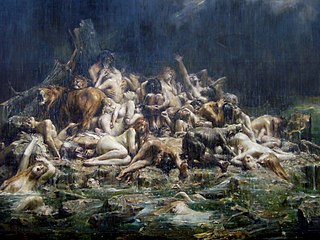 W
WThe Genesis flood narrative is a flood myth found in the Tanakh. The story tells of God's decision to return the Earth to its pre-creation state of watery chaos and then remake it in a reversal of creation. The narrative has very strong similarities to parts of the Epic of Gilgamesh which predates the Book of Genesis.
 W
WHam, according to the Table of Nations in the Book of Genesis, was the second son of Noah and the father of Cush, Mizraim, Phut and Canaan.
 W
WJapheth, is one of the three sons of Noah in the Book of Genesis, in which he plays a role in the story of Noah's drunkenness and the curse of Ham, and subsequently in the Table of Nations as the ancestor of the peoples of the Aegean Sea, Anatolia, and elsewhere. In medieval and early modern European tradition he was considered to be the progenitor of the European peoples.
 W
WJavan was the fourth son of Noah's son Japheth according to the "Generations of Noah" in the Hebrew Bible. Josephus states the traditional belief that this individual was the ancestor of the Greeks.
 W
WKittim was a settlement in present-day Larnaca on the east coast of Cyprus, known in ancient times as Kition, or Citium. On this basis, the whole island became known as "Kittim" in Hebrew, including the Hebrew Bible. However the name seems to have been employed with some flexibility in Hebrew literature. It was often applied to all the Aegean islands and even to "the W[est] in general, but esp[ecially] the seafaring W[est]". Flavius Josephus records in his Antiquities of the Jews thatCethimus [son of Javan] possessed the island Cethima: it is now called Cyprus; and from that it is that all islands, and the greatest part of the sea-coasts, are named Cethim by the Hebrews: and one city there is in Cyprus that has been able to preserve its denomination; it has been called Citius [or Citium/Κίτιον] by those who use the language of the Greeks, and has not, by the use of that dialect, escaped the name of Cethim.
 W
WLud was a son of Shem and grandson of Noah, according to Genesis 10.
 W
WMadai is a son of Japheth and one of the 16 grandsons of Noah in the Book of Genesis of the Hebrew Bible. Biblical scholars have generally identified Madai with the Iranian Medes of much later records. The Medes, reckoned to be his offspring by Josephus and most subsequent writers, were also known as Madai, including in both Assyrian and Hebrew sources. Some scholars in more modern times have also proposed connections with various earlier nations, such as Mitanni, Matiene, and Mannai. In addition, the Kurds still maintain traditions of descent from Madai.
 W
WMagog is the second of the seven sons of Japheth mentioned in the Table of Nations in Genesis 10.
 W
WIn the Bible, Meshech or Mosoch is named as a son of Japheth in Genesis 10:2 and 1 Chronicles 1:5.
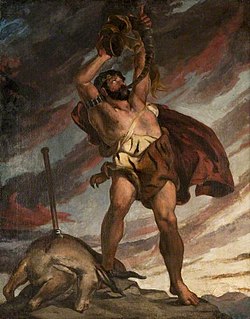 W
WNimrod, a biblical figure described as a king in the land of Shinar (Mesopotamia), was, according to the Book of Genesis and Books of Chronicles, the son of Cush. The Bible states that he was "a mighty hunter before the Lord [and] ... began to be mighty in the earth". Extra-biblical traditions associating him with the Tower of Babel led to his reputation as a king who was rebellious against God.
 W
WNoah's Ark is the vessel in the Genesis flood narrative through which God spares Noah, his family, and examples of all the world's animals from a world-engulfing flood. The story in Genesis is repeated, with variations, in the Quran, where the Ark appears as Safina Nūḥ.
 W
WPathrusim together with Casluhim were descendants of Mizraim according to the genealogies in Genesis, who inhabited Pathros.
 W
WSalah, Shelah, or Sala is an ancestor of the Israelites according to the Table of Nations in Genesis 10. He is thus one of the table's “seventy names.” He is also mentioned in Genesis 11:12–15, 1 Chronicles 1:18–24, and Luke 3:35.
In Judaism, the Seven Laws of Noah, otherwise referred to as the Noahide Laws or the Noachian Laws, are a set of imperatives which, according to the Talmud, were given by God as a binding set of universal moral laws for the "sons of Noah" – that is, all of humanity.
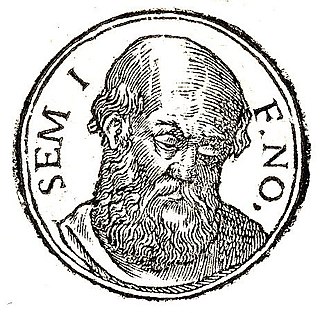 W
WShem was one of the sons of Noah in the Hebrew Bible as well as in Islamic literature.
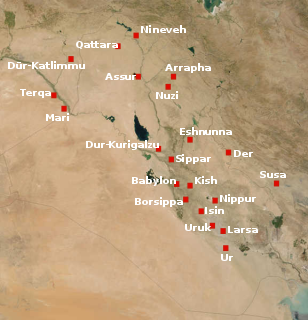 W
WShinar is the southern region of Mesopotamia in the Hebrew Bible.
 W
WTarshish occurs in the Hebrew Bible with several uncertain meanings, most frequently as a place far across the sea from Phoenicia and the Land of Israel. Tarshish was said to have exported vast quantities of important metals to Phoenicia and Israel. The same place-name occurs in the Akkadian inscriptions of Esarhaddon and also on the Phoenician inscription of the Nora Stone in Sardinia; its precise location was never commonly known, and was eventually lost in antiquity. Legends grew up around it over time so that its identity has been the subject of scholarly research and commentary for more than two thousand years.
 W
WTerah or Terach is a biblical figure in the Book of Genesis, son of Nahor, son of Serug and father of the Patriarch Abraham, all descendants of Shem's son Arpachshad. Terah is mentioned in the Hebrew Bible and New Testament.
 W
WTogarmah is a figure in the "table of nations" in Genesis 10, the list of descendants of Noah that represents the peoples known to the ancient Hebrews. Togarmah is among the descendants of Japheth and is thought to represent some people located in Anatolia. Medieval traditions variously claimed Togarmah as the mythical ancestor of peoples in the Caucasus and western Asia, including the Georgians, the Armenians and some Turkic peoples.
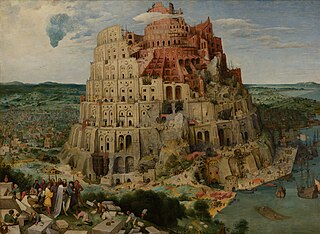 W
WThe Tower of Babel narrative in Genesis 11:1–9 is an origin myth meant to explain why the world's peoples speak different languages.
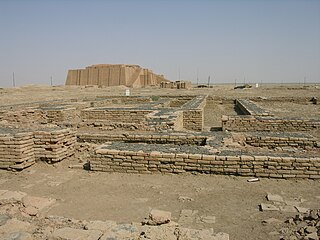 W
WUr Kaśdim, commonly translated as Ur of the Chaldeans, is a city mentioned in the Hebrew Bible as the birthplace of the Israelite and Ismaelite patriarch Abraham. In 1862, Henry Rawlinson identified Ur Kaśdim with Tell el-Muqayyar, near Nasiriyah in southern Iraq. In 1927, Leonard Woolley excavated the site and identified it as a Sumerian archaeological site where the Chaldeans were to settle around the 9th century BCE. Recent archaeology work has continued to focus on the location in Nasiriyah, where the ancient Ziggurat of Ur is located.
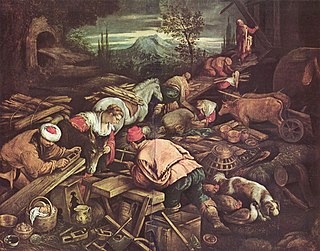 W
WThe wives aboard Noah's Ark were part of the family that survived the Deluge in the biblical Genesis flood narrative. They are the wife of Noah, and the wives of each of his three sons. Although the Bible only notes the existence of these women, there are extra-Biblical mentions regarding them and their names.